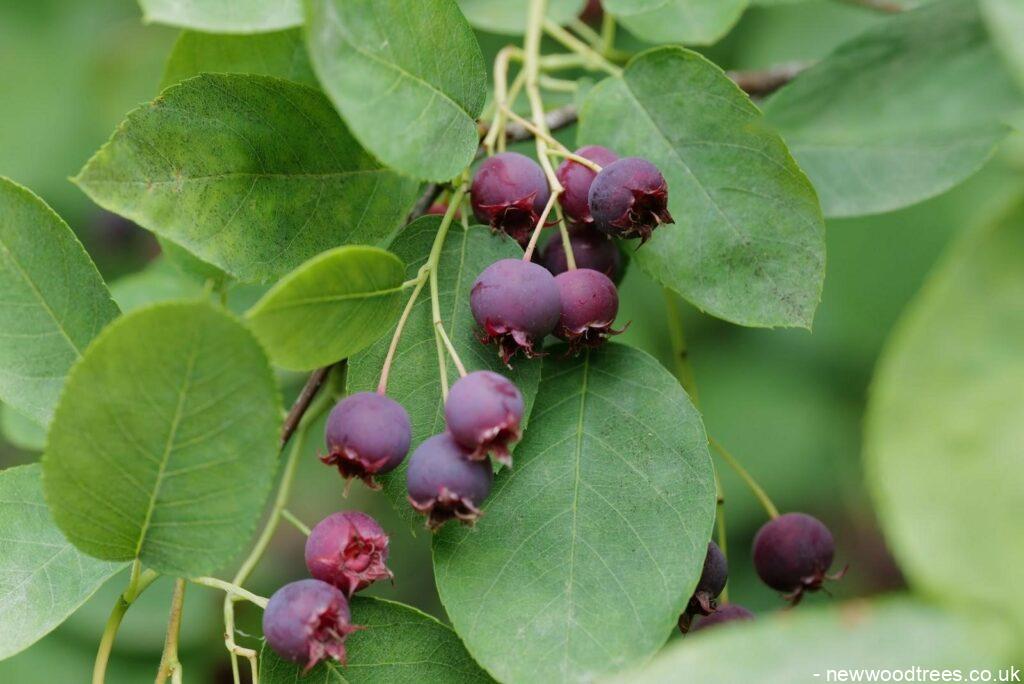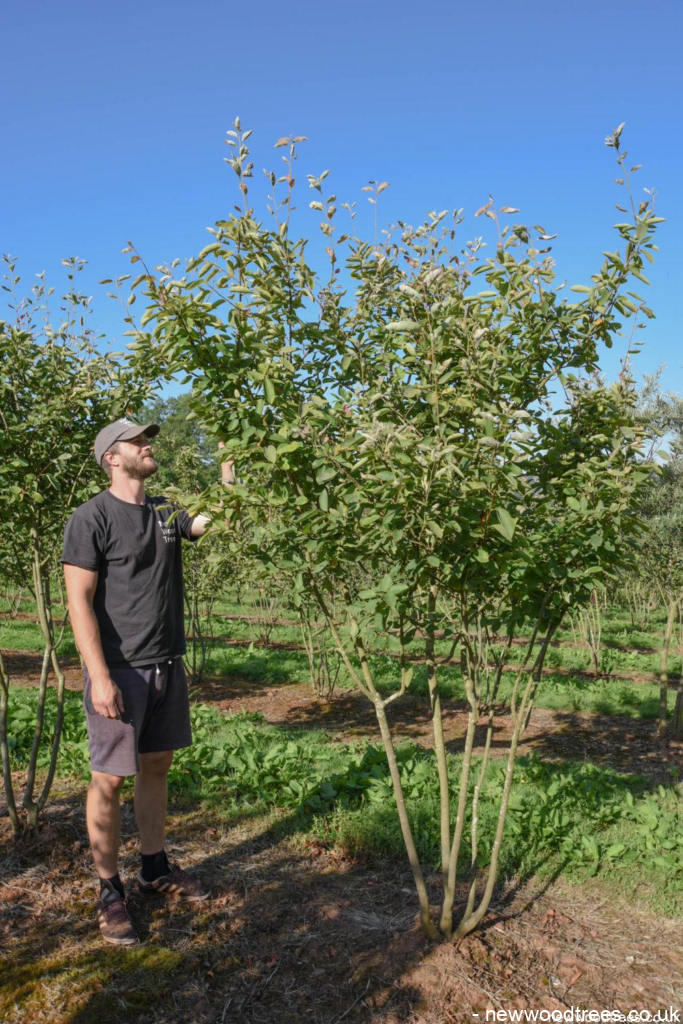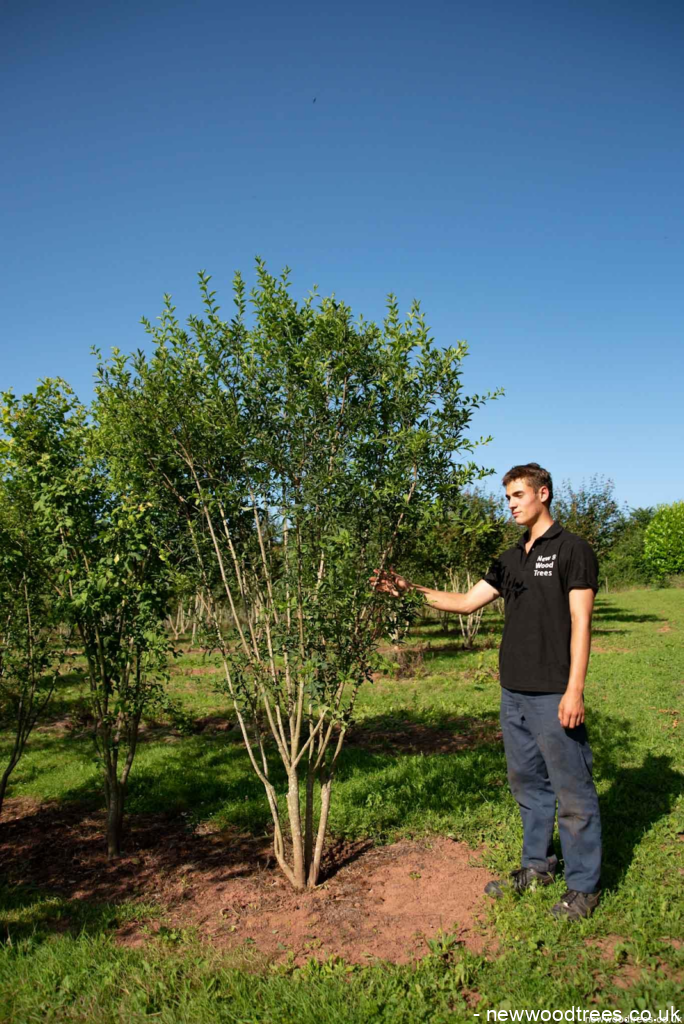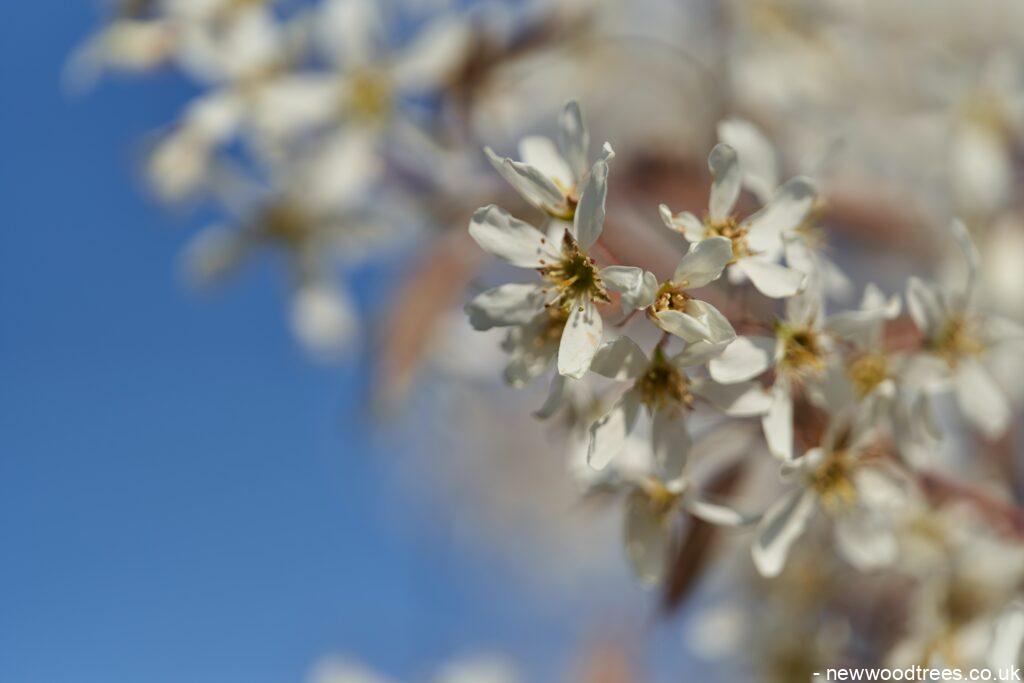An Amelanchier is also called the snowy Mespilus, June serviceberry, or shadbush – a shrub commonly found in North America. Amelanchier’s “snowy mespilus” name is drawn from its ability to produce starry white flowers that flourish in the late spring.
The tree develops copper-red leaves after the shedding of flowers, which then turn green during the summer and rock in red in autumn. Since Amelanchier is a moisture-loving tree, it can produce currant fruits. These Amelanchier edibles are available in autumn.
Overall, Amelanchier is an excellent tree for small gardens and can rarely go beyond 5 meters high.
Are you still asking if you can keep an Amelanchier small? Yes, you can.
However, you must do regular pruning and proper maintenance. In addition, the shape of your amelanchier will mostly depend on the selected variety. Some Amelanchier variants can grow into large, rounded shrubs or small trees.
How To Deal with Overgrown Amelanchier
If you have a shrubby suckering Amelanchier, consider stooling (cutting down to the ground) right after flowering. However, it’s advisable to exercise caution and opt for doing only half in the first year.
Alternatively, you can ‘lift the skirt’ of the shrubbier varieties by removing the lower branches to a height of two feet. This allows you to plant directly up to the main stem, but it’s suitable only for shade-loving plants.
Whichever method you choose, your Amelanchier will regrow to its former size or even larger relatively quickly. If this regrowth is not acceptable to you, the alternative is to remove the plant.
Incorporate deep, sultry tulips or a mix of pink and purple tulips with your Amelanchier’s white blossoms and dark foliage for an exquisite combination. If you’re planning to plant, aim for November or December. Choose tulip varieties that bloom in late April or May to align with the Amelanchier’s flowering.
Explore the option of introducing pulmonarias with pink-toned flowers. ‘Leopard’ offers a charming brick-pink shade with green foliage marked by regular silver splashes. On the other hand, ‘Raspberry Splash’ showcases petite raspberry-pink flowers and slender leaves. Alternatively, a golden yellow variety such as Malus ‘Evereste’ could be a delightful choice for your garden.
Embracing Nature’s Bounty: The Tale of Amelanchier

Let me introduce you to the amazing world of Amelanchier, also known as the Juneberry or Serviceberry. These cool shrubs and small trees belong to the Rosaceae family and call North America, Europe, and Asia their home sweet home. You can spot them chilling’ in temperate regions. Remember that Amelanchier comes in all sorts of shapes and sizes.
Now, let’s get fancy. “Amelanchier” has a French origin, coming from the word “amelanche,” which means “serviceberry.” Why? Well, it turns out that back in the day, people would snag these berries during church services to whip up some tasty jams, pies, and desserts.
Either way, the good part of Amelanchier is not only about their flavour. They are also the superheroes of nutrition. Amelanchiers contain antioxidants (vitamins C and E) and dietary fibre. If you find them delicious, they are also wholly ready to treat your body.
In the early spring, Amelanchier throws a floral fiesta. Clusters of these cute white or pink flowers pop up before the leaves do. Having said that, this phenomenon gives bees and other buzzing insects a reason to dance. It’s like a natural beauty pageant right in your backyard.
Even though Amelanchier is nutritionally valuable, it also has a medicinal impact. Research shows that the native American tribes have been using different parts of Amelanchier to tackle digestive issues, respiratory stuff, and even skin conditions.
Amelanchier trees are also good for the environment. Birds, like thrushes, robins, and waxwings, can’t get enough of these berries. The dense foliage also becomes a cosy home for birds and small animals. From sunny spots to shady corners, this plant knows how to thrive.
In the wild world of urban life, the Amelanchier shines. Low-maintenance and resilient, these plants can handle city pollution and compacted soils like a boss. The flowers are a buzzing hub for nature’s dance of pollination.
In a nutshell, Amelanchier is like that versatile friend who brings joy, flavour, and a touch of nature wherever it goes. So, why not let a bit of Amelanchier magic into your world? It’s a decision your taste buds and garden will thank you for.
Is Amelanchier the Perfect Ornamental Delight for Your Garden?
Amelanchier is a captivating shrub that stands between 3 to 5 meters tall. Typically, homeowners use multi-stem trees to add a touch of elegance to gardens. In early April, the Amelanchier tree dons a beautiful white ensemble of star-shaped flowers, creating a delightful feast for buzzing bees.
Beyond its enchanting blossoms, Amelanchier remains ornamental throughout the year, showcasing a leafage that transitions from bronze hues in spring to the warm tones of red and gold in the autumn months. The flowers, typically star-shaped and predominantly white, may occasionally exhibit a subtle pinkish hue in certain varieties.
Come summer, the shrub bears purple-coloured berries, a delectable treat for those fortunate enough to gather them before birds do. These serviceberries, also known as chuckley pears in Quebec, are edible and can be savoured raw and in culinary delights like pies and jam.
Amelanchier proves to be a low-maintenance plant adaptable to various settings, whether nestled in a shrub bed, standing alone, or serving as a vibrant addition to a mixed hedge or flowered hedge. An added allure is its ability to attract birds, a trait shared among the 25 diverse varieties that make up this genus. Amelanchier combines beauty, utility, and ecological appeal in your outdoor space.
The Top Three Amelanchier Varieties
1. Amelanchier x grandiflora ‘Robin Hill’
Height: 6 – 8 m
This recently introduced cultivar boasts clusters of pink buds that unfold into pale pink flowers during spring. As these flowers mature, they transition to a pristine white before gracefully falling. Enjoy edible berries from June to August.
The young leaves emerge in a captivating bronze hue, gradually darkening to a lush green in late spring and summer. In autumn, they transform into vivid shades of orange and deep red before gracefully dropping. This variety forms a charming small garden tree.
2. Amelanchier lamarckii ‘Ballerina’
Height: 4 – 5 m

A delightful and low-maintenance shrub or small tree, ‘Ballerina’ is adorned with large white flowers in spring. During spring and summer, the leaves of Amelanchier lamarckii showcase an attractive cool green shade.
It further transitions to bright red, orange, or gold hues in the autumn before gracefully falling. This makes it an excellent choice for planting as a stand-alone specimen or as part of a mixed border in your garden.
3. Amelanchier ovalis ‘Edelweiss’
Height: 3 – 4 m
This amelanchier is native to Central and Southern Europe. It has a slower growth rate. In late spring, it showcases six-inch-long panicles of white flowers. The leaves start in a captivating pink-bronze shade when young. It will transform into a cool green in spring and summer. If you are in need of yellow to red autumn colour, try out the Euonymus europaeus.

Still, the culmination of Amelanchier ovalis is eye-catching hues of orange, red, and yellow during a crisp autumn. Once established, this tree yields small black fruit in mid to late summer, attracting birds to your garden. ‘Edelweiss’ proves to be a superb ornamental plant suitable for gardens of most sizes.
How Should You Take Care of Amelanchier
Amelanchier trees are known for their low-maintenance nature. They require minimal attention to flourish. Optimal growth is achieved in moist soil with good drainage. Regarding sunlight, the growing area can have either complete sun rays or partial shade. The relatively acidic soils are favourable for Amelanchier. However, it’s advisable to avoid chalky soil. For vibrant autumn colours, selecting a sunnier location in your garden is recommended.
Enhance the visual appeal of your garden by pairing these spring-flowering trees with perennials. Consider a stunning combination of Amelanchier Obelisk with the Malus ‘Evereste’ and Rhododendrons. They offer splendid floral displays in the spring.
Amelanchier proves to be frost-hardy and robust. That can eliminate the need for winter shelter. While some Amelanchier varieties have naturalized in the United Kingdom, most originate from North America. That aspect contributes to their exceptional hardiness in the UK and resilience to subzero temperatures.
Pruning Amelanchier trees is a straightforward task. You will only use minimal effort to maintain their shape. Simply remove any dead or damaged growth, and the plant will flourish. It would be best if you prune Amelanchier in late winter. That is before the flowering season begins. At this time, you can still trim them to achieve the desirable size or shape.
Conclusion
Explore the beauty of Juneberry varieties, with the enchanting blush blooms of Robin Hill transforming into a pristine white as the season progresses. Versatile and striking, these ornamental trees can serve as a focal point in small gardens or mixed shrub borders. Plant them near patios to enjoy not only a light shade but also the delightful fragrance of spring. Uncover the charm of Juneberry trees and elevate the allure of your outdoor space.







